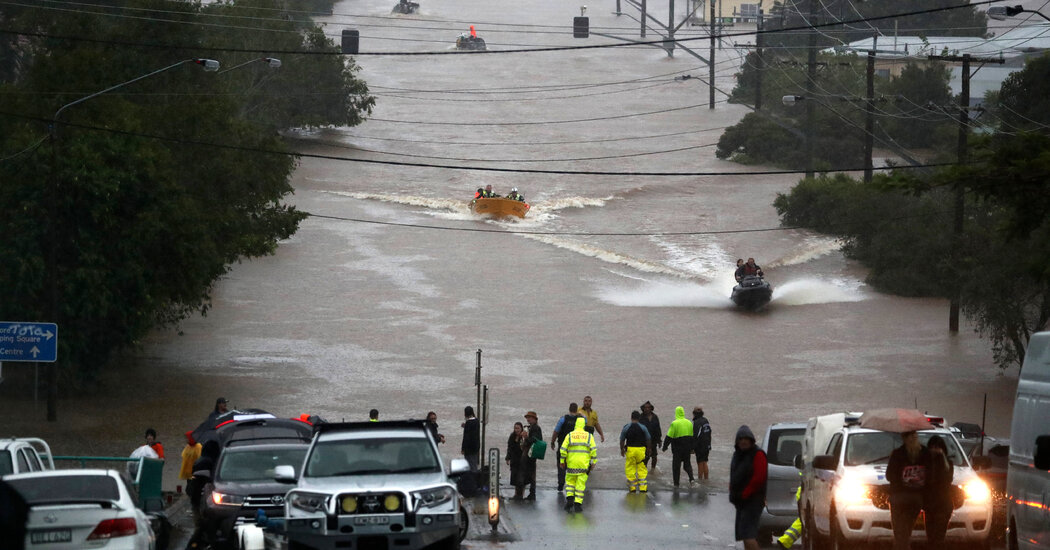
MELBOURNE, Australia — At least nine people have died from the flash flooding that has battered northeastern Australia in the past few days, with the wild weather forcing residents to evacuate and schools to close, while thousands of homes have been left inundated.
Queensland has been hit the hardest, with torrential rain pummeling towns and cities since last Tuesday and slowly moving south to engulf the state’s capital, Brisbane.
Photographs and videos from the city on Monday morning showed the Brisbane River extremely swollen and many streets severely flooded, with extensive damage to roads, buildings and vehicles caught in the downpour. Usually busy thoroughfares were submerged.
Up to 18,000 homes across the state have been affected, the authorities estimated, with about 15,000 of those in Brisbane. More than 1,500 people have been evacuated and about 53,000 homes were without power on Monday morning. Hundreds of schools are closed, and officials have asked residents to work from home. Residents have been asked to conserve water after flooding knocked a water treatment plant offline on Sunday. On Monday morning, the rain had eased and the Brisbane River had peaked at 12.6 feet. It was expected to peak again in the afternoon.
The heaviest rain is moving south to New South Wales, where the town of Lismore is experiencing its worst flooding on record. Torrential rain on Sunday night caught the authorities off guard and left residents little time to evacuate, with many becoming trapped in attics and stranded on roofs as floodwaters quickly rose.
Steve Krieg, the mayor of Lismore, on Monday described the situation as “a tragedy unfolding in front of our eyes,” adding that 400 people were estimated to be trapped.
Stranded residents took to social media to beg for assistance. Locals reported hearing people screaming for help from inside homes, and as floodwaters continued to rise, some resorted to cutting themselves out of roofs, residents said on social media.
Officials expect the town’s river to peak at about 52 fee late on Monday. More than 15,000 people have been urged to evacuate along the New South Wales north coast, and the military has been deployed to aid evacuation efforts.
Australia has been buffeted by particularly extreme weather over the past few years, including catastrophic fires, drought and widespread flooding.
According to experts, the country, a giant landmass as large as the continental United States and surrounded by climate-driving oceans, has suffered weather extremes for millenniums, including harsh droughts ending with major floods. But though some of the factors driving those swings are ageless, climate change is increasing the likelihood of severe downpours.
New South Wales’s premier, Dominic Perrottet, on Monday called the flooding “unprecedented” and warned that conditions would worsen throughout the week as the storm system continued to move south.
“There are many distressing reports, particularly around the Lismore area, of people who are isolated and currently stranded,” he added.
Annastacia Palaszczuk, the state premier of Queensland, on Sunday described the latest calamity as a “rain bomb.”
“It’s just coming down in buckets,” she said at a news conference. “It’s not a waterfall, it’s like waves of water just coming down.”
Ms. Palaszczuk compared the weather to an “unpredictable cyclone” and said that the authorities had not expected the storm system to sit over the state for so long.
Of the nine people who have died since Wednesday, eight were in Queensland and one was in the state of New South Wales, the authorities said.
The body of a man in his 50s and that of his dog were found in his car on the Gold Coast on Monday morning after the vehicle was swept away by floodwaters.
Others include a 34-year-old Brisbane man who died trying to escape his submerged car on Sunday morning and a volunteer emergency worker who died when her vehicle was swept away while she was on her way to help a family trapped by the floodwaters.
In Brisbane, even residents accustomed to wild weather — Queensland experiences some degree of flooding nearly every year — were surprised at the unrelenting pace of the rain that drenched the city for four days straight.
“It just kept pouring,” said Sandy Casey, 77, who evacuated her Brisbane home on Sunday afternoon. “The water kept coming — we watched it come up to the house.”
She stayed in her home until the power went out, she said. By that point, the roads were too flooded to drive through, so she crossed several backyards that were on raised ground to make it a location where she could be picked up and driven to safety.
Photographs and videos posted to social media showed houses submerged to their roofs and floodwater touching the tops of traffic lights.
Some have taken to using boats, including kayaks, to get around though the authorities have urged residents to stay out of the water.
The town of Gympie, where two deaths occurred, saw its worst flooding since 1893.
The last time Queensland faced similarly catastrophic flooding was in 2011, when 33 people were killed after torrential rain fell over several weeks. That disaster affected over 200,000 people and caused billions of dollars of damage.
Meghan Dansie contributed reporting.




